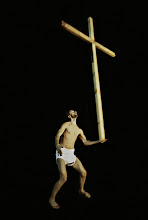Visions of Excess is curated by Ron Athey and Lee Adams. The event stages 12 hours of intense gestures, images and performances on the subject of death, eroticism and the forbidden.
Overspill: Visions of Excess is a collaborative durational writing event initiated by Overspill writers Alex Eisenberg and Rachel Lois Clapham. It is a sympathetic critical response to Visions of Excess and will involve 12 hours of live writing in the Shunt Vaults, including dialogue from audience members and artists. The writing will be posted online during the event.
In advance of the event, Rachel Lois muses on different aspects of extreme or explicit live performance: the first of which is porosity, or the body without limits. The second prelude is the contract between audience and performer in performance.
...................................
Prelude #2: The performance contract
For the performer, negotiating the chain reaction that is initiated with the audience in a performance is always a concern, particularly when the work is of an intimate or explicit nature. The stakes are high; the audience’s potential to react, act upon the artist, impact upon her body, to intervene into her work - whether invited or not – is intellectually, emotionally and physically crucial. The artist is made particularly vulnerable in performance due to the personal, intimate yet very public nature of her work. She is also usually far outnumbered by audience. The question is how to ensure safety, maintain personal limits. When the work is about exploring those very limits, how can the performer explore and transgress them on her own terms?
In the Salon ‘Sex’ at Edge Bar, Soho, on Monday, Spill Festival Thinker in Residence, Kira O’Reilly, talked about how she negotiates these limits in her live work, which often includes acts of cutting and cupping with, or in close proximity to, the audience. She talked of the advice given to her from artist Annie Sprinkle to ‘only do what you want to do’. Similarly, artist Samantha Sweeting talked about audience expectation in her breast feeding performances: she indicated that her own feelings about breastfeeding (after several hours of it at least) are often at odds with any sexual fantasy or pleasure the audience may have when encountering the work.
What emerges in both artists’ comments is an implicit distinction between performer and audience; a gap in meaning, agency and experience between the two in the moment of performance. This gap is important in work such as O’Reilly’s and Sweeting’s. It manifests the non-consumable, or the impossibility of desire for the other, that is the fundamental premise of eroticism. But this separation, and what lies across or within it, also represents meaning in and of itself. Just as the presence of bridges assumes a gap or distinction between separated people or places, so too the distinction in agency, agenda or action between performer and audience manifests as a highly contingent relationship, negotiation or bond between the two in the moment of performance. This bond is thick with agendas, difference, desire and conflict, but it is a contract nevertheless, one in which both audience and performer has equal but different agency and responsibility towards the acts depicted – whether as collaborator, witness, voyeur, victim or aggressor, the desirous or desired subject.
Later tonight, the audience will enter Visions of Excess. We will enter with a desire to experience healing, sex, tenderness, intimacy, outrage and/or introspection in all its forms. We will play an integral part in the performances, but we don’t yet know how, or what this will entail. We will all enter with Annie Sprinkle’s adage to ‘only do what you want to do’ in mind, knowing that as we explore, reach and breach our individual and collective limits, something else is being played out: something of the mutuality of the performance contract, the reciprocity of responsibility that makes performance contingent; something of institutional and social relations that are otherwise concealed or beyond formal legal jurisdiction.
Rachel Lois Clapham is a writer, curator and co-director of Open Dialogues.

.jpg)
No comments:
Post a Comment